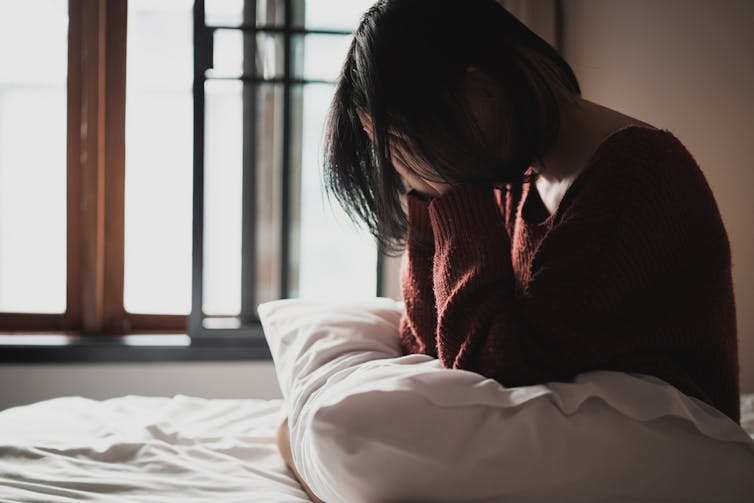Women in abusive relationships are more likely to be unemployed and earn less money than women with non-abusive partners.
That’s among the key findings confirmed by a landmark international study by researchers from England, America and Finland, which charted the economic impact abusive relationships have on women.
The study found that the deterioration in economic wellbeing started soon after women began living with an abusive male partner. After five years, these women continued to experience significant falls in earnings and employment.
Read more: Revealed: the hidden problem of economic abuse in Australia
What is economic abuse in a domestic relationship?
We know from previous research that men use economic abuse to exert power over and exploit their female partners.
It can involve using intimidation, threats, humiliation, emotional manipulation, isolation and physical violence to restrict their partner’s right to work and access to property, including
preventing her from taking a job
forcing her to resign
undermining her work performance
restricting the type of job they can do
preventing her from accessing bank accounts
excluding her from decision-making over household spending or joint property
preventing her from accessing joint financial assets
making her relinquish control over her property or income, or
compelling her to take on her partner’s debt.
This abuse sabotages a woman’s independence and ability to leave the relationship by limiting her access to money and work outside the home.
Economic abuse is more common than many realise. A recent online survey of 15,000 women in Australia found 11% had experienced coercive control. Of this group, just over half reported their partners had used their own or shared money without consent or made important financial decisions without consulting them.
What did the new study set out to do?
The new empirical study involved a data set of nearly 14,000 cohabiting couples. The study’s authors linked information from unusually comprehensive police and economic databases in Finland to chart men’s economic abuse of their female partners.
The researchers compared women who had reported domestic abuse to police with a matched sample of women who had not reported abuse.
By employing a relatively long time span (from 2006 to 2019), the study was able to chart the points at which physical violence and economic abuse most frequently occurred.
The researchers were also able to identify if the women had been in a non-abusive relationship. This allowed them to compare economic outcomes in both situations.
What did the new study find?
When women in abusive and non-abusive relationships were compared after five years living with a partner, the employment rates for those in abusive relationships fell 12% and their earnings declined 26% relative to their situation before cohabitating.
The researchers were able to exclude other factors that might have contributed to this outcome, such as a general economic downturn or working less outside the home after starting a relationship.
By referring to other relationships, they could also establish that these negative outcomes had not occurred when the same women had been in a non-abusive relationship.
In other words, the negative outcomes were a product of the abuse rather than any characteristics of the victim-survivors. These findings refute claims these women have only themselves to blame.
The researchers were also able to identify that a negative impact on economic wellbeing occurred relatively early in abusive relationships. Women’s unemployment tended to increase and their earnings tended to decrease within the first two years of a couple living together.
The study also found women “in the middle” – those with intermediate levels of education and earnings before entering into a relationship that became abusive – experienced the worst economic outcomes.
It’s not clear why. Perhaps this was the least predictable group in relation to whether they would leave the relationship and this may have triggered the most control from their abusive partners.
The study also found that economic abuse usually preceded physical violence, but could also occur in relationships where there was no reported violence.

How to end this abuse?
Economic abuse in intimate relationships builds on existing gendered inequities, especially social norms about management of finances.
Changing the attitudes and behaviours of perpetrators and potential perpetrators is crucial. Many consent and behaviour change programs include economic abuse as a recognised form of coercion and control.
It’s also important we find ways to improve financial literacy and provide more support for women seeking to leave abusive relationships.
Australian banks have already developed useful guidelines and are working with experts in domestic and family violence to promote understanding of this abuse.
It’s vital that we find ways to support women to deal with the predictable consequences of economic abuse. These include homelessness, home insecurity, unemployment, poverty, and debts accrued by a partner or former partner.
Without intervention, a bad credit rating or poor rental history caused by a perpetrator’s abusive conduct can blight women’s lives for years after they leave these relationships.
Taking out a civil protection order may prohibit further economic abuse. New South Wales and Tasmania already have criminal laws targeting coercive control and economic abuse. Queensland is planning to introduce a coercive control offence.
Enacting similar laws in other states and territories would extend these protections to even more Australian women.
Read more: Coercive control is a key part of domestic violence. So why isn't it a crime across Australia?

